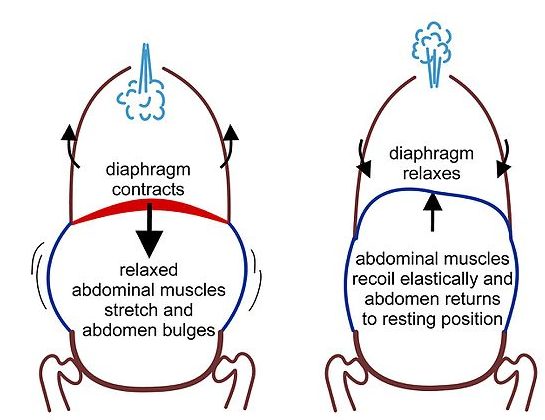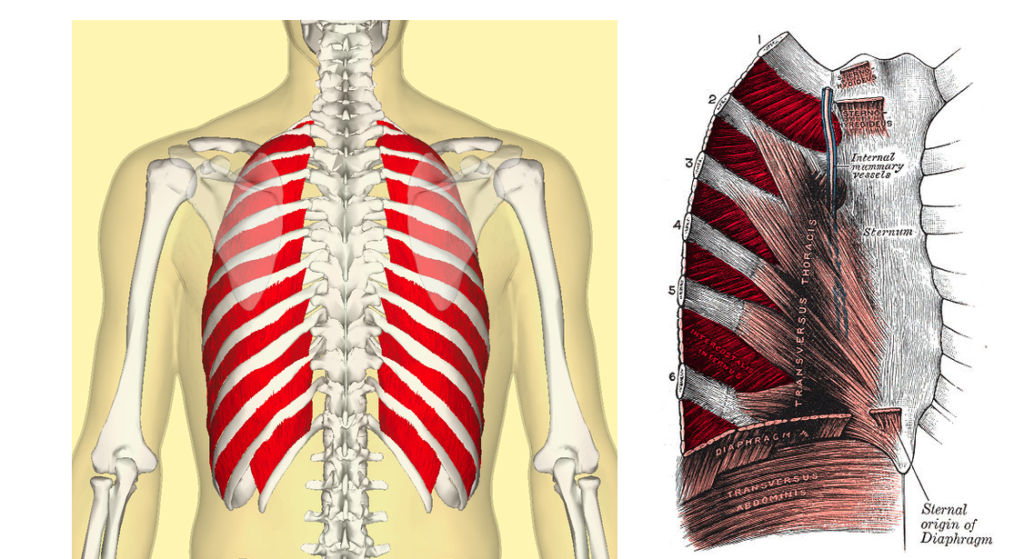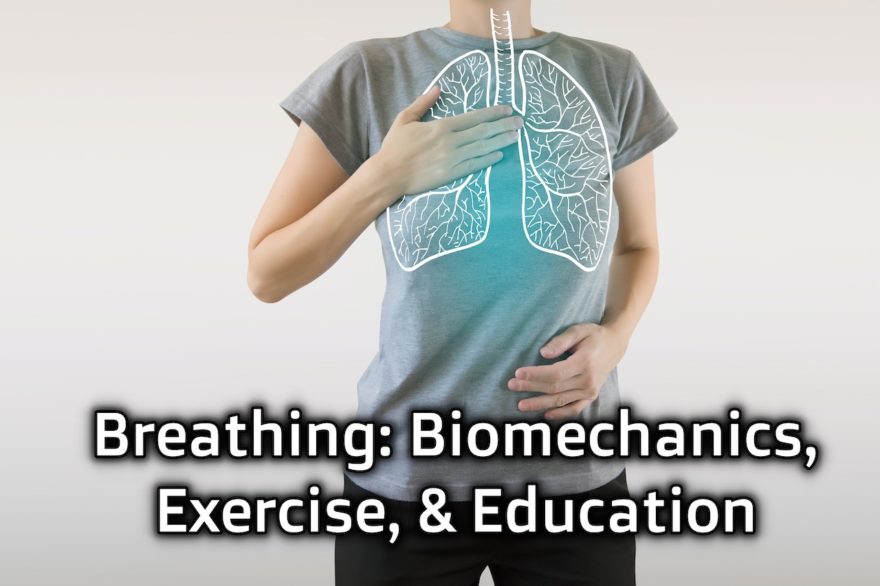Table of Contents
Do you ever get asked why are you breathing like that during an exercise?
Or worse yet, maybe you’ve gotten in ANOTHER Facebook argument with some trainer or clinician who is skeptical of breathing.
Despite typing feverishly, throwing all caps on that comment, everything you can, no luck.

It’s interesting to consider why some peeps think of breathing as this separate piece from movement. It’s something esoteric, different.
When in reality…
- Breathing affects pelvic floor dynamics, impacting how your hips move
- Breathing influences the intra-abdominal pressure needed to move heavy ass weights
- You upper body and cervical mobility can be impacted by breathing. Not sure if you know this, but uh, most of your upper quadrant muscles attach to the ribcage fam!
Breathing isn’t something fancy, but an integral piece of how we move and perform.
If maximizing your movement quality sounds like something you want to learn how to do, take advantage of breathing.
To implement breathing into your training, you’ll need to learn some biomechanics, apply airflow to your favorite lifts, and educate others so you can show them the way, the truth, and the light.
Don’t worry fam, I got you with Movement Debrief Episode 126.
Watch the video below for your viewing pleasure, or listen to the podcast audio if you can’t stand the sight of me 🙁
and the audio version:
If you want to watch these live, add me on Instagram.

 t
tShow notes
Check out Human Matrix promo video below:
Below are some testimonials for the class:
Want to sign up? Click on the following locations below:
August 1st-2nd, Boston, MA (Early bird ends July 5th at 11:55pm!)
September 12th-13th, Montreal, Canada (Early bird ends August 16th at 11:55pm!) [6 CEUs approved for Athletic Therapists by CATA!]
October 3rd-4th, Ann Arbor, MI (Early bird ends September 6th at 11:55pm!)
November 7th-8th, Charlotte, NC (Early bird ends October 11th at 11:55pm!)
November 21st-22nd, San Diego, CA (Early bird ends October 25th at 11:55pm!)
February 20th-21st, 2021, Atlanta, GA (Early bird ends January 17th at 11:55 pm!)
May 1st-2nd, 2021, Minneapolis, MN (Early bird ends April 4th at 11:55pm!)
Dickinson College in Carlisle PA (POSTPONED DUE TO COVID-19) [Approved for 14 Category A CEUs for athletic trainers]
Or check out this little teaser for Human Matrix home study. Best part is if you attend the live course you’ll get this bad boy for free! (Release date not known yet 🙁
Here is a signup for my newsletter to get nearly 5 hours and 50 pages of content, access to my free breathing and body mechanics course, a free acute:chronic workload calculator, basketball conditioning program, podcasts, and weekend learning goodies:
[yikes-mailchimp form=”1″ submit=”Get learning goodies and more”]
Role of the diaphragm in trunk rotation in humans – So it turns out the diaphragm doesn’t create a whole lot of motion at the spine, but it does drive some extension in those with spinal cord injuries.
Action of the diaphragm on the rib cage – This article outlines how the lower ribcage movement occurs during inhalation and exhalation.
Respiratory Action of the Intercostal Muscles – This article deep dives into how the intercostal muscles function.
Bill Hartman – Arcs of flexion, breathing, this is my go-to guy for this. He taught me just about everything I know. He’s my dad after all 😉
Reaching: Theory and Practice – Want to learn how reaching at different angles influences shoulder motion? Then you’ll definitely want to check this one out. I also talk about trunk rotation on this one.
If you want to improve buckethandle dynamics like crazy, then you gotta try the rib shake pulldown. If you are wondering, my rib shake DOES bring all the boys to the yard!
If you are wanting to beef up your evidence on all the things we talk about, check out my references page.
Loserthink – This book is incredible at helping navigate all the logical fallacies and thinking pitfalls you and everyone haves. Prepare to get hit with MAJOR cognitive dissonance.
Win Bigly – If you want to beef up your persuasion game, then this book is a must.
How does your lumbar spine move when you breathe?
Question: You describe inhalation as a general posterior expansion of the spine to accept the depressed abdominal contents, which causes a reduced lumbar lordosis among other things.
However, I’ve read that inhalation as causing increased lumbar lordosis due to the diaphragmatic attachments to the anterior spine. The latter makes sense to me given the importance of the exhalation in creating an ideal stack, but the concepts you have been describing very much do as well.
It would be incredible if you could help me understand this, as I feel like this confusion confounds my ability to understand how the upper and lower parts of the ventral cavity are functionally linked.
Thank you!!
Answer: What if I told you both answers were right? 🙂

The difference is between the respiratory AND postural function of the diaphragm.
If you contract the diaphragm in isolation, the action on the lumbar spine is extension.
However, isolated contraction is not what happens in respiration. Instead, many tissues contract to pull air into the lungs. In general, there is a multidirectional expansion of the ventral cavity during inhalation.
As the diaphragm descends, the viscera downwardly displace, and the pelvic floor must eccentrically elongate to catch the viscera. Stretch to catch if you will (#stretch2catch, could be hashtag of the year).

When this action happens, sacral counternutation occurs to increase the pelvic inlet surface area. Sacral counternutation and lumbar flexion are paired movements. Hence, why lumbar flexion is right.
So then when would the diaphragm extend the lumbar spine?
If the diaphragm descends to flat, a maximal concentric contraction, there will be increased postural demands on the diaphragm. This, combined with increased accessory breathing muscle activity will create lumbar extension during inhalation.
How does your thoracic spine move when you breathe?
Question: Hey Zac, I have a question for you. I’ve been following what you teach and I know your breathing mechanisms but something has been bugging me!
When we make an inhalation, our ribs rotate externally and this is related to spinal extension but when we inhale, our spine goes in kyphosis too.
Is it possible that extension and kyphotisation happen at the same time? What am I missing here?
Thanks a lot for your time.
Answer: The big question to answer this question is “what in the heck are the intercostals doing in the ribcage?”
I’M GLAD YOU ASKED!!!!
Which intercostals are active during respiration are based on location and neural drive. Peep this study to learn more, but the two intercostal types that are active during inhalation are:
- Parasternal intercostals (those surrounding the sternum)
- Dorsal rostral intercostals (those surrounding the posterior upper 6 ribs

When these muscles contract, they will cause anterosuperior movement of the front ribs, and posterior superior movement of the upper back ribs. This would in theory cause “extension” in the lower thoracic region, and “flexion” in the upper thoracic region. But on the real, you’ll see circumferential expansion of the ribcage in all directions when you breathe in.
Realize though fam, it’s a small amount during quiet breathing. The more volitional your breath gets, the more expansion you will see.
How to breathe to address specific movement restrictions
Question: Does how you coach breathing change based on if it is an exercise that is intended to influence an exhalation(ie. hip extension) or inhalation(i.e hip flexion) limitation?
Answer: In general, the extremity mechanics paired with respiration are as follows:
- Inhalation: Flexion, abduction, and external rotation
- Exhalation: extension, adduction, and internal rotation
When I say these are paired, if you drive flexion in the extremities, the spine will assume inhalation mechanics, and vice versa with extension. They help create the desired bias.
If I want to reinforce a given bias, I can time my breathing to sequence these movements to maximize the effect.
If we assume that someone can keep a stack during a movement (ha), we can throw a breath on top of that action to theoretically drive more desired motion.
Don’t do this at the expense of overwhelming your client with cues. Not cool, bruh.
Breathing during upper body exercises
Question: Hey Zac, I was wondering if you could do an episode regarding when to breathe to bias different expansion strategies for some upper body weight-room exercises:
- Pull-ups
- Chest supported rows
- Incline presses
- Alternating rows/presses
- 1 arm pull-downs
Answer: This question totally depends on your arm position and when you breathe. Let’s go into each of these.
Pullups and Pulldowns
A pullup can improve buckethandle dynamics for both infrasternal angles at the start. If you are wide and exhale, you’ll close the lower ribs. If you can inhale with ab tension at the start, that’s perfect for a narrow.
As you progress towards the pullup bar, you’ll get more pumphandle expansion.
A word of movement restoration caution. If you are lifting HEAVY ASS WEIGHTS on these pullups, you will need to drive a lot of concentric force to move da weight. You’ll likely not get the movement options you so desire (but who cares when you got that v-shaped torso amiright!??!)
If you do these things unilaterally, like with 1 arm pulldowns, you can drive WAY greater buckethandle dynamics because of the allowable sidebend.
Chest supported row
Due to this movement being roughly at 90 degrees of shoulder flexion, you’ll get mostly pump handle mechanics during the start, with an increase as you row.
If you do this move unilaterally, then you can drive a bit of trunk rotation towards the straight arm.
Incline presses
Ah, my chest is warm just thinking about these. Mostly from the hella gainzzz.
Lower inclines will bias more pump handle, increasing during the lower similarly to the chest supported row.
As you up the incline grade though, prepare to get filthy.
Higher inclines will drive more upper posterior thorax expansion (T2-T4) because of the eccentric orientation of the rhomboids.
Educating skeptical professionals on breathing
Question: Right now I´m diving into the whole breathing/biomechanics/movement information you provide. I live in Germany where nobody really knows shit about the stuff you talk about.
A lot of people are very critical of the concepts I play around with.
Do you have any advice on how to get clients & other coaches to come to the Light Side?
Also, can you share some studies that can help me back up the stuff I´m talking about (especially pelvic movements during breathing/squatting/hinging, movement variability, effects of the 90/90 hip lift)?
People always want to “see the evidence” so it would be nice to just stuff some studies down their throat so that I can keep on learning in peace.
Also, I kinda wanna know that what you´re talking about is actually true 😉 Keep doing what you´re doing! Lots of love from Germany!
Answer: When you are going up against people who believe differently than you (read: haterz), you have to play this situation cool. I like to go straight up Socrates on dat azz.

Here is your order of operation:
- Seek to understand their point and beliefs. Explain what they believe in a way they wish they would’ve. Who knows? They may actually change your mind!
- Find common principles. If you can find things you agree upon, they’ll be more receptive to what you say.
- After you’ve successfully completed steps 1 & 2 (are you sure you did it??? DO IT AGAIN!), then, and only then, can you provide counterpoints to their argument. This could be providing research or asking them challenging questions that they’d have a hard time with.
I also find it useful to ask someone “what is something you think I believe that you don’t?” They could be misinterpreting what you are saying, then you can provide a more accurate representation.
These conversations are best had in person, as you can better appreciate nuance then arguing in front of your computer monitor.
Sum Up
- Normal inhalation causes a relative reduction of a lumbar curve due to sacral counternutation, but lumbar extension can increase with a maximal concentric diaphragmatic contraction
- In general, inhale if you are going after flexion, abduction, and external rotation restrictions; exhale if you moving into extension, adduction, and internal rotation restrictions
- If overhead, you can bias buckethandle mechanics and upper thorax expansion. The lower your arms go, the more lower thorax expansion occurs.
- When educating others who believe differently than you, seek to understand them first, find common principles, and then (AND ONLY THEN) respectfully challenge their thought process.
How do YOU implement breathwork during training with you and your clients? Comment below and let the fam know!

